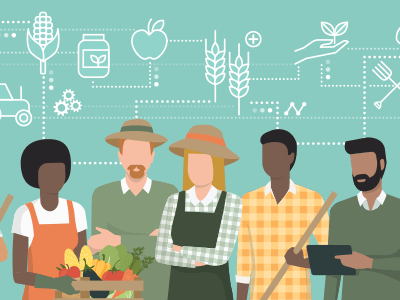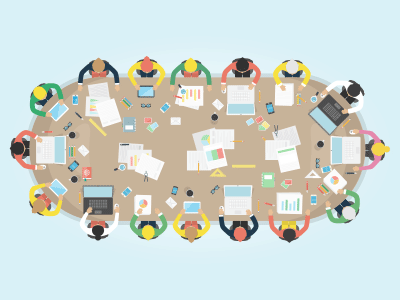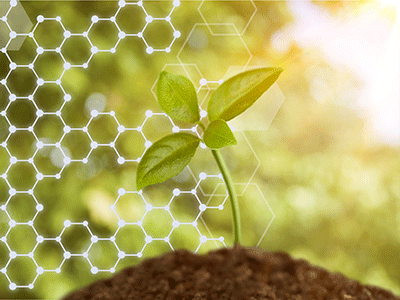Opportunities and threats for agriculture
Challenges and opportunities for the global food system
Tambien disponible en español | Egalement disponible en français
Resource depletion and climate change pose major challenges
Food, agriculture, and fisheries depend on the world’s natural resources, so future food production will depend on how well these resources are conserved and used. Agriculture is impacted by urban land expansion and by higher water demand from other sectors. Development in coastal zones complicates fisheries governance in traditional fishing areas. The ocean ecosystem is affected by oil and gas exploration, marine shipping, and land-based industries, whose pollution can lead to habitat loss and declining biodiversity. Agricultural risk “hotspots” occur where these resource pressures are most concentrated. These places are expected to have the most difficulty maintaining food production.
The demand for resources is complicated by climate change. By 2050, climate change could cause global average yields of rice, wheat and maize to be between 6-10% less than they otherwise would be, while water stresses in key regions in Northwest India, Northeast China and Southwestern United States could by themselves cause an increase in the international price of the same crops by 5 to 7% by 2050.
The food, agriculture and fisheries system is not only impacted by the environment, but also by production techniques that can affect impact land, water, biodiversity, and greenhouse gasses.
The agriculture sector is directly responsible for 12% of global greenhouse gas emissions, mostly due to methane emissions from livestock and rice, and from nitrous oxide emissions from fertilisers. It is the largest water consuming sector, and can harm biodiversity and reduce water quality from runoff of fertiliser, manure, and pesticides. The excessive use of nutrients in agriculture has been a major source of water pollution, and is estimated to have reduced biodiversity in rivers, lakes and wetlands by about one-third globally.
OECD analysis shows that while progress has been made in improving the impact of agriculture on the environmental and natural resources, there are still significant challenges in the use of resources and pollution in many countries.
Overfishing, including illegal fishing, has led to depleted fish stocks, with about one-third of global marine stocks biologically overfished, up from about 10% in the mid-1970s. This threatens the functioning of marine ecosystems and results in fewer opportunities for fishers. Better fisheries management systems could generate an additional USD 80 billion in value each year.
As global demand for food and non-food products continues to increase, driven largely by population and income growth, the challenge of addressing resource depletion and climate change can also be expected to increase. The world’s population is projected to reach 9.5 billion by 2050, with much of the increase taking place in Sub-Saharan Africa, India, the Middle East and North Africa. Income growth in developing and emerging countries is also stimulating demand for more, and a greater diversity of, food and non-food products.
Digital technologies could help address some of these challenges
Digitalisation holds considerable potential to transform the food, agriculture and fisheries system in coming years. Mobile devices, data analytics, high quality satellite imagery, precision equipment, and artificial intelligence – amongst others – could contribute greatly to increase productivity, sustainability and resilience across the sector. In principle, new technological developments could make it possible for farmers to monitor their crops and livestock with greater precision, to fine-tune applications of inputs (such as fertilizers and feed supplements), and to use large amounts of data to determine optimal agriculture and aquaculture production choices. Farmers and fishers could more easily connect to markets and to essential up-to-date market information, while traceability systems can follow products along the value chain, providing consumers with information on the orgin of food they buy.
Digital technologies could also enable more comprehensive monitoring of illegal fisheries, helping to manage stocks more sustainably. They can also help target and improve agriculture and environmental policies by linking support to verifiable outcomes, and to facilitate cross-border trade, for example by automating administrative and customs procedures.
Some of these technologies exist today, while others are still in early stages of development. In either case, digital applications in agriculture will not automatically be available to all. Special attention will be required to ensure that farmers and fishers in less developed economies, and those in more remote areas, can benefit. In many cases this will mean significantly increased (public and private) investment in digital infrastructure and in education and training; failure to make these investments risks to create a ‘digital divide’ that would leave too many behind.
Better policies could help address some of these challenges today
There is a growing urgency for governments to realign policies in light of the emerging challenges and opportunities. Governments could begin immediately to roll back policy measures that can potentially harm the environment, including by encouraging unsustainable production. Doing so would also release scarce financial resources that could be devoted to high-return investments in innovation systems, in physical and digital infrastructure, in targeted climate and environmental measures, and in risk management systems. Such targeted and tailored policy efforts would pave the way for progress to be made opening markets for freer and fairer trade in food, agriculture and fisheries products.
Better policies can be underpinned by strengthened international cooperation, both to create better information on shared risks (climate and other environmental changes and on research and development gaps, for example) and to identify potential solutions of widespread interest (climate-resilient infrastructure, land and water management, weather related risk mitigation, and new digital applications, for example).
Changing policies for food, agriculture and fisheries is seldom easy, as potential impacts on rural livelihoods, income distribution, and competitiveness create significant uncertainties. Policy reform processes must be well designed to enable those affected to have a voice, to anticipate negative impacts, and to have in place transitionary support to facilitate desired structural adjustments. National governments can work with sub-national public bodies, businesses, and civil society groups to strengthen domestic cooperation, both to facilitate policy reform and to address local problems, including in particular as regards the environment.
How we feed the world today
The global food system continues to respond to the needs of a growing and more affluent world population. Learn how we got here.
What governments are doing
Government policies and interventions play a major role in shaping food and agriculture markets, but policies are not always well aligned to evolving objectives.
What is the future of food and farming?
How the global food, agriculture and fisheries system evolves in coming decades will depend on targeted measures to ensure that no one is left behind.


